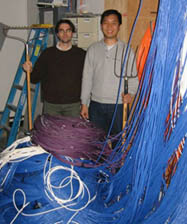
| "Bandwidth Farming:" Graduate students Felix Hernandez Campos and Long Le prepare to rake through a tangle of networking cable. More about the department's network upgrade project below. (Photo: Kevin Jeffay) |

In This Issue
- Chairman's Corner
- Welcomes and Farewells
- Congratulations to...
- Research Highlights
- Short Bits
- Recent Publications
- Undergraduate News
- Family Matters
- Alumni News
- In the Media
- Computer Services News
- In Memoriam
- About News & Notes
Chairman's Corner
We welcome Richard Superfine and Sean Washburn of the Department of Physics and Astronomy at UNC-Chapel Hill to our faculty as adjuncts. Both already have a long association with our department, as advisers and directors of our graduate and undergraduate students, and as principal or co-principal investigators on grants.John Eyles and John Poulton became adjuncts in December. During the past two years, both were on off-campus assignment while they worked at Velio Communications, Inc., and both chose to stay full time with the company at the end of that period. Velio designs innovative signaling and switch-fabric integrated circuits.
We are sorry to say goodbye to James Coggins, former associate professor, who has joined NetIQ Corp. in Research Triangle Park, N.C. James had been with us since 1986 and had served six years as associate chairman for academic affairs. We wish him well in his new endeavor.
Several of our students recently received awards and honors. See inside for details.
Many thanks to all of our faculty, staff, and students who in December generously donated canned goods and money to help needy families in Orange County. I was able to deliver 20 bags of groceries to the Inter-Faith Council for Social Service in Carrboro. Administrative manager Katrina Coble, who organized the donation effort, collected enough $30 donations to feed 12 needy families. Thanks to all for your generosity during the holiday season to help the less fortunate.
Spring has arrived in Chapel Hill; truly one of the most beautiful times to be here. Please visit us if you have the chance!
Stephen F. Weiss

"Bandwidth Farming:" Graduate students Felix Hernandez Campos and Long Le prepare to rake through a tangle of networking cable. More about the department's network upgrade project below. (Photo: Kevin Jeffay)
Welcomes and Farewells
Sean Washburn, Adjunct Professor (Lyle V. Jones Professor, Physics and Astronomy; Chair, Applied and Materials Sciences, UNC-Chapel Hill), Ph.D. 1982, Duke. Condensed matter physics, materials science.
New Students, Spring 2002
Richard Mukherjee, Jason Stewart, Jingyu Yan, and Bingzhao Yang.
Thanks and farewell to . . .
Robert-Paul Berretty, postdoctoral researcher, who
worked with Jack Snoeyink, professor, in the area of
computational geometry from January to December 2001. He is
now a research scientist with Philips Research in Utrecht,
The Netherlands. (berretty@cs.unc.edu)
Donna Knighten, accounting assistant, who left in February 2002 to join Construction Management in Facilities Services at UNC-Chapel Hill. Her new position, as Administrative Secretary II, is a promotion. Donna had worked with us since November 1998. (dknighten@fac.unc.edu)
Congratulations to...
Kevin Jeffay, S. S. Jones professor, who was presented with an award for service to the real-time systems community at the 22nd annual IEEE Real-Time Systems Symposium in December 2001.
Madelyn Mann, who was promoted to Program Assistant V, effective 25 February 2002.
Tammy Pike, who was promoted to Office Assistant IV, effective 19 November 2001.
Graduate Students
Bill Baxter (M.S. 2000) and Ruigang Yang, who
received Link Foundation Fellowships.
Felix Hernandez Campos (M.S. 2001), who was awarded a fellowship grant from the Computer Measurement Group, Inc.
Michael Rosenthal, who received a Leadership Award from the American Medical Association Foundation (see below).
Vincent Scheib, who was awarded a National Science Foundation Graduate Research Fellowship.
Our December Graduates
Ph.D.
Gopi Meenakshisundaram, "Theory and Practice of
Sampling and Reconstruction of Manifolds with Boundaries"
(adviser: Jack Snoeyink)
Mark A. Parris, "Class-Based Thresholds: Lightweight Active Router-Queue Management for Multimedia Networking" (Kevin Jeffay)
Martin A. Styner, "Combined Boundary-Medial Shape Description of Variable Biological Shapes" (Guido Gerig)
M.S.:
Bonnie Danette Allen*, Felix Hernandez Campos*, Chad T.
Petty, Adam A. Seeger*, Andrew G. Zaferakis
*Continuing on to Ph.D. at UNC-Chapel Hill
B.S. Computer Science:
Christopher Schenck
B.S. Mathematical Sciences (CS Option):
Chandra Graham, Phillip Kinnaird, Sarath Kolluru, Andrew
Mackelfresh, Sahil Parikh, Jonathan Pence, and Adam S.
Ross.
Research Highlights
To address the problem, graduate student Felix Hernandez Campos (M.S. 2001) is creating a framework of application-class models, in which each class is distinguished by the common paradigm of how it is a source of network traffic. For each class, he is creating a single stochastic model to reflect the aggregated characteristics of all TCP applications that are members of that class. The researchers hope to represent a very large number of applications with a relatively small number of class-based models because--given this set of models and the desired proportion of each class--one can generate synthetic traffic for network simulations with an arbitrary mix of applications. In his research, he is collaborating with Andrew Nobel, associate professor of statistics.
Whitaker Foundation Funds Surgical Simulation System
Stephen R. Aylward (Ph.D. 1997), assistant professor
of radiology and adjunct assistant professor of computer
science, is the principal investigator on a new three-year
grant, "Vessel Visualization and Quantification for
Partial-Organ Transplant Planning and Evaluation," funded
by the Whitaker Foundation. The goal of the project is to
develop a surgical simulation system that will help with
planning partial liver transplants between a patient and a
living donor related to that patient; specifically when
both donor and recipient are adults. Donations from living
parents to their children have been extremely successful,
but adult-to-adult transplant surgery has been much more
difficult for the donor to tolerate since the survival of
an adult recipient relies upon a larger graft donation than
that required for a pediatric recipient. Studies show that
30 to 67 percent of livers have anomalous hepatic vascular
anatomy. Because reviewing 2D slices of MR or CT scans is
often insufficient to detect these anomalies, Aylward and
his colleagues are developing software that will allow a
surgeon to interactively visualize 3D models of a liver's
vascular network based on MR and CT scans; to analyze them;
and to specify a surgical path through them in 3D. The
software will also help the surgeon to predict the outcome
of a potential transplant. Researchers hope that surgeons
also will be able to use the system to plan many other
minimally invasive procedures that are driven by an organ's
vascular network, such as partial-lung transplants, liver
lesion ablations, and brain tumor resections.
(caddlab.rad.unc.edu)
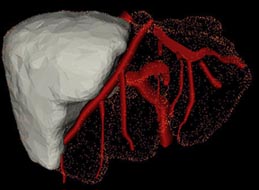
| Visualization for liver transplant cutting path assessment. The Whitaker Foundation is funding a new simulation system to help surgeons plan partial liver transplants. |
New Tele-Immersion Project to Train Surgeons
Using VR
Researchers at UNC-Chapel Hill and Brown University are
collaborating on a new project to develop tele-immersion
technology for training surgeons. Andries Van Dam,
professor, of Brown is principal investigator and
Gregory F. Welch (Ph.D. 1997), research associate
professor, of UNC-Chapel Hill is co-principal investigator
on the project, "Electronic Books for the Tele-Immersion
Age: A New Paradigm for Teaching Surgical Procedures,"
which received one of the National Science Foundation's
competitive Information Technology Research awards.
Henry Fuchs, Federico Gil professor, and Herman
Towles, senior research associate, are also
participating at UNC-Chapel Hill. Colleagues from the
University of Pennsylvania will also collaborate
indirectly. The project will involve both computer
scientists and medical professionals and will build on
prior work by the computer scientists.
The researchers recognized that with the dramatic increase in the pace of surgical innovations, mechanisms for training and re-training surgeons on the new methods have become inadequate. The limitations of traditional videotaped instruction make it an ineffective training tool, but having the surgeon actually observe the new procedure is often not practical. They envision an immersive "time machine"; a virtual environment that allows the trainee to walk freely and naturally around a life-sized, high-fidelity, 3D graphical reconstruction of a past surgical procedure, pausing or stepping forward or backward in time to satisfy curiosity or allay confusion. The environment would incorporate commentary from the original surgeon or another instructor, integrated 3D illustrations, annotations, and relevant medical metadata. Although they are concentrating on trauma surgery, the researchers envision many other possible applications for the technology. (www.cs.brown.edu/research/graphics/research/itr/#eBook)
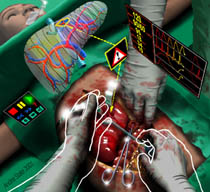
| In a new tele-immersion project, researchers will develop technology to train surgeons. (Image: Andrei State) |
nanoManipulator Team Goes Back to School
In February, nanoManipulator team members spent a week at
Orange High School in Hillsborough, N.C., conducting
instructional workshops for approximately 120 students.
Students listened to presentations by scientists, learned
about the nanoscale science at the heart of the project,
and used the nanoManipulator to experiment with viruses.
Each student had the opportunity to interview two of the
scientists or computer scientists on the team, which
consisted of UNC-Chapel Hill faculty and students in the
departments of Computer Science and Physics and Astronomy,
the School of Education, and the Curriculum in Applied and
Materials Sciences. Team members looked at the impact on
the students of using the nanoManipulator across a live
Internet connection to the Atomic Force Microscope,
compared to using saved stream files. They also
investigated the impact of haptic feedback on students'
conceptions of viruses.
This visit was the latest of several that the nanoManipulator team has made to Orange High. Past visits have shown that the project has been successful in increasing students' interest in science, and their understanding of various fields of science and what scientists do. Students have reported enjoying the chance to meet and interact with UNC-Chapel Hill faculty and students. (www.cs.unc.edu/Research/nano/)
RTSS 2001
The 22nd Annual IEEE Real-Time Systems Symposium (RTSS)
took place in London, England, in December 2001. RTSS is
the premier technical conference for real-time systems
research. Kevin Jeffay, S.S. Jones professor, was
the general chair of the conference. The program committee
included Jim Anderson, professor, Sanjoy
Baruah, associate professor, and Giuseppe
Lipari, a former visiting graduate student at
UNC-Chapel Hill, who is currently on the faculty at Scuola
Superiore Santa Anna in Pisa, Italy. The IEEE Technical
Committee on Real-Time Computing gave Jeffay an IEEE
Service Award, in recognition of his services to the
real-time systems community.
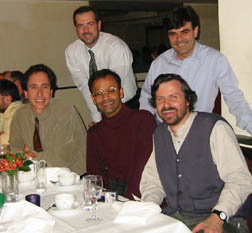
| At RTSS 2001, seated (from left): UNC-Chapel Hill computer science faculty Kevin Jeffay and Sanjoy Baruah, with Gerhard Fohler of Malardalen University in Sweden. Standing (from left): Giorgio Buttazzo of the University of Pavia in Italy, and Guiseppe Lipari of the Scuola Superiore Santa Anna in Italy. (Photo: Maya Jerath) |
Several papers had UNC-Chapel Hill links. Graduate student Shelby Funk (M.S. 2001) presented "On-Line Scheduling on Uniform Multiprocessors," co-authored with her adviser, Baruah, and former departmental visitor Joel Goossens. Graduate student Phil Holman presented "Guaranteeing Pfair Supertasks by Reweighting," co-authored with his adviser, Anderson. Bjorn Andersson, a student at Chalmers University in Sweden, presented "Static-Priority Scheduling Upon Multiprocessors," co-authored with Baruah and Jan Jonsson (also of Chalmers). Both Lipari and Gerardo Lamastra, who visited UNC-Chapel Hill for several months during 2000 and who is currently at Telecom Italia, also presented papers.
RTSS 2002 will be held this December in Austin, Texas. Baruah will chair the program committee, which will once again have a significant UNC-Chapel Hill presence. (www.cs.unc.edu/~baruah/Meetings/2002-RTSS/)
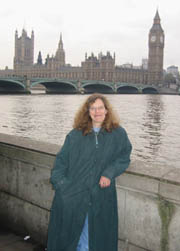
| Graduate student Shelby Funk takes time out from RTSS 2001 for some London sightseeing. (Photo: Kevin Jeffay) |
Short Bits
Best Panel Award
Professor Dinesh Manocha participated in the
"Commodity Graphics Accelerators for Scientific
Visualizations" panel, which received the "Best Panel"
award at IEEE Visualization 2001. Other panelists were Tom
Funkhouser of Princeton, Greg Humphreys of Stanford, and
Joe Kniss of Utah. The panelists discussed the role of
modern graphics hardware in future visualization research.
Best Paper at Web3D Symposium
Graduate student Martin Isenburg and professor
Jack Snoeyink received the best paper award at the
2002 Web3D Symposium for "Coding Polygon Meshes as
Compressable ASCII." Their encoding allows the benefits of
geometric data compression in text-only file formats such
as VRML, an issue that has been without an agreed-upon
solution since 1996.
Sonnenwald on Fulbright
Diane Sonnenwald, adjunct associate professor, is
spending this spring on a Fulbright fellowship at the
University of Tampere in Finland. She is teaching a short
course on the socio-technical aspects of collaboration,
including the design and evaluation of collaboration
technology. Sonnenwald is presenting a number of talks at
Tampere and at the University of Oulu. She is also spending
time writing and visiting several industrial research
labs.
Teaching Portfolio Used as Model
Jeannie Walsh, lecturer and director of general
studies, has had her teaching portfolio selected by the new
Center for Teaching and Learning at Pohang University of
Science and Technology in South Korea. The center's
director, Sang-il Choi, formerly a physics professor at
UNC-Chapel Hill, will use her portfolio to help train his
faculty.
Andersson, B., S. Baruah, and J. Jonsson. "Static-Priority Scheduling on Multiprocessors," Proc. IEEE Real-Time Systems Symposium, December 2001, 193-202.Recent Publications
Baruah, S., J. Haritsa, and N. Sharma. "On-Line Scheduling to Maximize Task Completions," Journal of Combinatorial Mathematics and Combinatorial Computing, Vol. 39, 2001, 65-78.
Brooks, F. P. "The History of IBM Operating System/360," Proc. SD&M Software Pioneers Conference, 2001.
Fisher, S., and M. Lin. "Fast Penetration Depth Estimation for Elastic Bodies Using Deformed Distance Fields," Proc. IEEE/RSJ International Conference on Intelligent Robots and Systems, October 2001.
Foskey, M., M. Otaduy, and M. Lin. "Touch-Enabled 3D Model Design," Proc. IEEE VR Conference, March 2002.
Funk, S., J. Goossens, and S. Baruah. "On-Line Scheduling on Uniform Multiprocessors," Proc. IEEE Real-Time Systems Symposium, December 2001, 183-192.
Guthold, M., J. Mullin, S. Lord, R. Superfine, R. Taylor, and D. Erie. "Investigating the Mechanical Properties of Individual Fibrin Fibers with the Nanomanipulator AFM," Biophysical Journal, Vol. 80, 2001, 1274.
Guthold, M., R. Superfine, and R. M. Taylor II. "The Rules are Changing: Force Measurements on Single Molecules and how they Relate to Bulk Reaction Kinetics and Energies," Biomedical Microdevices, Vol. 3, 2001, 9-18.
Holman, P., and J. Anderson. "Guaranteeing Pfair Supertasks by Reweighting," Proc. IEEE Real-Time Systems Symposium, December 2001, 203-212.
Isenburg, M., and J. Snoeyink. "Spirale Reversi: Reverse Decoding of Edgebreaker Encoded Meshes," Computational Geometry: Theory and Applications, 20(1-2), October 2001, 39-52.
Isenburg, M., and J. Snoeyink. "Coding Polygon Meshes as Compressable ASCII," Proc. Web3D Symposium 2002, 1-10. (best paper)
Jeffay, K., T. Hudson, and M. Parris. "Beyond Audio and Video: Multimedia Networking Support for Distributed, Immersive Virtual Environments," Proc 27th EUROMICRO Conference, September 2001, 300-307.
Kim, Y., M. Otaduy, M. Lin, and D. Manocha. "Six-Degree-of-Freedom Haptic Display Using Localized Contact Computations," Proc. IEEE Haptics Symposium, March 2002.
Low, K.-L., G. Welch, A. Lastra, and H. Fuchs. "Life-Sized Projector-Based Dioramas," Proc. ACM Symposium on Virtual Reality Software and Technology, November 2001.
Mascarenhas, A., S. Ehmann, A. Gregory, M. Lin, and D. Manocha. "Six Degree-of-Freedom Haptic Visualization," Touch in Virtual Environments, McLaughlin, Hespanha, and Sukhatme, eds., Prentice Hall, 2002.
Miller, D., and G. Bishop. "Latency Meter: A Device for Easily Monitoring VE Delay," Proc. SPIE Electronic Imaging Symposium, January 2002.
O'Brien, D., S. Fisher, and M. Lin. "Simulation Level of Detail for Automatic Simplification of Particle System Dynamics," Proc. Computer Animation 2001, 210-219.
Ozdag, R., M. Singh, P. Beerel, and S. M. Nowick. "High-Speed Non-Linear Asynchronous Pipelines," Proc. Design, Automation and Test in Europe, March 2002.
Raskar, R., and K.-L. Low. "Interacting with Spatially Augmented Reality," Proc. ACM AFRIGRAPH 2001.
Rosenthal, M., A. State, J. Lee, G. Hirota, J. Ackerman, K. Keller, E. D. Pisano, M. Jiroutek, K. Muller, and H. Fuchs. "Augmented Reality Guidance for Needle Biopsies: A Randomized, Controlled Trial in Phantoms," Proc. Medical Image Computing and Computer-Assisted Intervention 2001, 240-248.
Seeger, A., S. Paulson, M. Falvo, A. Helser, R. M. Taylor II, R. Superfine, and S. Washburn. "Hands-On Tools for Nanotechnology," Journal of Vacuum Science & Technology, Vol. B19, 2001, 2717-2722.
State, A., J. Ackerman, G. Hirota, J. Lee, and H. Fuchs. "Dynamic Virtual Convergence for Video See-Through Head-Mounted Displays: Maintaining Maximum Stereo Overlap Throughout a Close-Range Work Space." Proc. International Symposium on Augmented Reality 2001, 137-146 + 2 color plates, front cover.
Taylor II, R. M., T. C. Hudson, A. Seeger, H. Weber, J. Juliano, and A. T. Helser. "VRPN: A Device-Independent, Network-Transparent VR Peripheral System," Proc. ACM Symposium on Virtual Reality Software & Technology 2001.
Tierno, J., A. Rylyakov, S. Rylov, M. Singh, P. Ampadu, S. Nowick, M. Immediato, and S. Gowda. "A 1.3 GSample/s 10 tap Full-Rate Variable-Latency Self-Timed FIR Filter With Clocked Interfaces," Proc. International Solid State Circuits Conference Digest of Technical Papers, February 2002.
Varadhan, G., W. Robinett, D. Erie, and R. M. Taylor II. "Fast Simulation of Atomic-Force-Microscope Imaging of Atomic and Polygonal Surfaces Using Graphics Hardware," Proc. SPIE Electronic Imaging Symposium, January 2002.
Undergraduate News
Students majoring in computer science will receive rigorous training in the foundations of the field and related mathematics, with ample opportunity to specialize in software systems, programming languages, theoretical computer science, or applications of computing technology in science, applied mathematics, medicine, or business. Students will be required to take a sequence of courses in computer science as well as in related disciplines including mathematics, physics, and statistics. According to Kevin Jeffay, S. S. Jones professor and director of undergraduate studies, the new major will offer new courses and has the flexibility to respond to changes in the field over time.
Currently about 30 juniors and seniors are enrolled in the new major. Although the size of the program may grow over time, Jeffay said that the department will always foster a sense of community among undergraduates, graduate students, and faculty, including one-on-one mentoring relationships; a distinct advantage over an undergraduate computer science program at a large engineering school.
To gain admission to the major, students must obtain a grade of C or better in the core courses in physics, mathematics and computer science. To graduate with a B.S. in computer science, students must achieve a C average or better in all junior/senior courses, and receive no grade lower than a C- in any of these courses.
In addition to taking classes, undergraduates can participate in many departmental and university activities. They may enhance their learning experiences by joining one of the department's research projects, or pursue self-directed research with a faculty member. They can also serve as lab assistants or teaching assistants for computer science courses, or gain valuable work experience as assistants on the Computer Services staff. Activities, such as the annual ACM programming contest (see article below), give students the chance to test their skills and knowledge against their peers at other universities.
Previously, students interested in computer science selected the computer science option offered by the Curriculum in Mathematical Sciences. The mathematical sciences major is being phased out and is being replaced by the computer science major and by a new program in decision sciences being offered by the departments of Operations Research and Statistics.
For more on the new major, see: www.cs.unc.edu/Bachelors/.
ACM Programming Contest
Two teams of undergraduates from UNC-Chapel Hill competed
in the regionals of the annual ACM Programming Contest last
fall and one team made it all the way to the finals this
spring. John Ehrhardt, Derek Hartman, Nate Massey, Chris
Schenck, Mike Trinh, and Matt Vross competed in
the Mid-Atlantic USA Programming Contest in Durham, N.C.,
in November. The team of Ehrhardt, Massey, and Schenck,
placed sixth, earning them a trip to the ACM International
Collegiate Programming Contest World Finals, held in
Honolulu, Hawaii, in March, along with 63 other regional
championship teams. Trinh accompanied them as an alternate,
and professors Kevin Jeffay and Ketan
Mayer-Patel went along as coaches. To win the joint
ACM/IBM-sponsored contest, teams from all over the world raced
against the clock to solve nine complex, real-world
problems in five hours. Although a team from Shanghai
JiaoTong University were the ultimate contest winners, the
UNC-Chapel Hill contestants did receive an honorable
mention.
(icpc.baylor.edu/icpc/finals/)
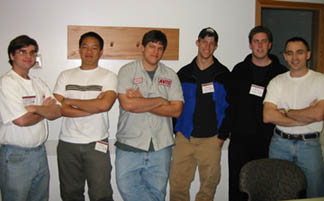
| The two teams at the regional programming contest in November, from left: Derek Hartman, Mike Trinh, Chris Schenck, John Ehrhardt, Nate Massey, and Matt Vross. |
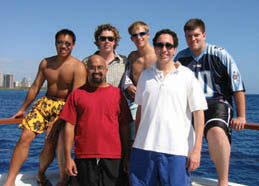
| In Hawaii, the programming team enjoys time off from the contest. Back (from left): Students Mike Trinh, Nate Massey, John Ehrhardt, and Chris Schenck. Front: Professors Ketan Mayer-Patel and Kevin Jeffay. |
Phi Beta Kappa Inductions
Congratulations to our undergraduates who were inducted
into Phi Beta Kappa during this academic year. Sachin
Patel and Nolan Walker, computer science majors,
and Courtney McCarthy, math sciences (computer
science option) major, were inducted on 19 November 2001.
Gregory R. Lanier, computer science major, was
inducted on 9 April 2002.
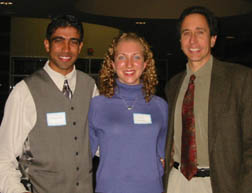
| Students Sachin Patel and Courtney McCarthy, and professor Kevin Jeffay at the November induction ceremony for Phi Beta Kappa. |
Fred and Nancy Brooks added a seventh grandchild on 23 December 2001. Ann Caroline Brooks was born in Irvington, N.Y., to Roger and Ann Brooks. She joins siblings Marie, Phil, and Henry. (brooks@cs.unc.edu)Family Matters
William London Carr was born on 19 August 2001 in Kenmore, Wash., to Michael Carr (M.S. 1991) and Susie Carr. (mwc67@hotmail.com)
Garrett William Hudson was born on 30 January 2002 in Wilmington, N.C., to Tom Hudson (M.S. 1997) and Challe Hudson. (hudsont@uncwil.edu)
Lorin Elizabeth Larsen was born on 26 February 2002 in Chapel Hill, N.C., to Scott and Amy Larsen. (larsene@cs.unc.edu)
Brina Marissa Lemke was born on 21 October 2001 in Palo Alto, Calif., to Steve Lemke and Audra Lemke (ne้ Sugerman) (M.S. 1995). (audra@lemkeville.org)
Dylan Frederick Pausch was born on 31 December 2001 in Pittsburgh, Pa., to Randy Pausch and Jai Glasgow Pausch, former outreach coordinator. (jaipausch@hotmail.com)
Stephen and Lyn Pizer have their first grandchild: Carina Jiaxin Luo born on 7 March 2002 in San Diego, Calif., to Roger and Tonia Luo. (pizer@cs.unc.edu)
Aditi Ramsisaria was born on 13 September 2001 in Chandigarh, India, to Alok Ramsisaria (M.S. 1991) and Neeta Ramsisaria. She has an older brother, Rishabh (4). (alok@konstruct.com)
Anand Srinivasan (M.S. 2000) and Chandna Bhatnagar (M.S. 2000) married in Cary, N.C., on 26 October 2001. (anands@cs.unc.edu, bhatnag@cs.unc.edu)
Alexandre Daniel Townsend was born on 3 October 2001 in Chapel Hill, N.C., to Jeff and Claire Townsend. (townsend@cs.unc.edu)
New School Named for Staff Member's Parents
The newest middle school in the Chapel Hill-Carrboro City School
district--the R. D. and Euzelle Smith Middle School, which was
officially dedicated on 11 November 2001--is named for the
parents of Andrea Bunn, accounting assistant. Between them,
the Smiths have given 75 years of service in various roles to the
community's secondary education program. The two were honored at
the dedication with a plaque and portrait, which will be
permanently installed at the school.
Alumni News
Chandna Bhatnagar (M.S. 2000) works at Cisco Systems in Research Triangle Park, N.C. She and current graduate student Anand Srinivasan (M.S. 2000) recently married (see "Family Matters"). (bhatnag@cs.unc.edu)
Randy Brown's (M.S. 1990) car--a 1994 Pontiac Firebird Formula (530 hp engine naturally aspirated and 700 hp on nitrous oxide)--appears on the May 2002 cover of GM High-Tech Performance magazine (www.gmhightechperformance.com), with an accompanying four-page feature article inside. (rbrown@rti.org)
Michael Carr (M.S. 1991) is still at Amazon.com, managing the Software Platform team. He and his wife, Susie, had their first child last August (see "Family Matters"). (mwc67@hotmail.com)
Ritu Chadha (Ph.D. 1991) is director of Service Management Research at Telcordia Technologies. She has been working on the design of Operations Support Systems for large service providers for provisioning IP services. During the past two years, Ritu has given several invited talks and tutorials on directory-enabled networks, policy-based management, and management of MPLS traffic engineering at various industry conferences. She lives in Hillsborough, N.J., with her husband, Arindam, and their four-year old daughter, Trisha. (chadha@research.telcordia.com)
Chun-Fa Chang (Ph.D. 2001) joined the Computer Science Department at the National Tsing Hua University, in Hsinchu, Taiwan, as an assistant professor in August 2001. He and his wife are expecting a baby girl, their second child in April. (chang@cs.unc.edu)
Rich Holloway (Ph.D. 1995) is vice president of Computer Systems Technology at 3rdTech, Inc. (www.3rdtech.com). At his previous job, with Volumetrics Medical Imaging, Inc., he was co-author on the patent, "Methods and Systems for Determining Velocity of Tissue Using Three-Dimensional Ultrasound Data" (U.S. Pat. No. 6,241,675). A brief description of the real-time volume-rendering project he worked on at Volumetrics appeared in Time magazine (see www.cs.unc.edu/~holloway for a copy) (holloway@3rdtech.com)
Tom Hudson (M.S. 1997) is finishing his Ph.D. and has begun a tenure-track position in the Department of Computer Science at UNC-Wilmington. He and his wife, Challe, had their first child in January (see "Family Matters") (hudsont@uncwil.edu)
Gopi Meenakshisundaram (Ph.D. 2001) has joined the Department of Information and Computer Science at the University of California at Irvine as an assistant professor. (gopi@ics.uci.edu)
Ulrich Neumann (Ph.D. 1993), an associate professor in the Department of Computer Science at the University of Southern California, was named director of the university's Integrated Media Systems Center (IMSC) in March. In his new post, he also holds the Charles Lee Powell Chair in Engineering. The IMSC has an $11 million annual budget and is the National Science Foundation's only Engineering Research Center for multimedia and Internet research. (uneumann@graphics.usc.edu)
David G. Stahl (M.S. 1993) is now an application developer for Virtual Solutions, Inc. (www.virtualsolutions.com) in Camp Hill, Pa. The company has developed a web-based application for verifying data--such as tax forms and credit card bills--that presents only portions of the scanned fields to the on-line data entry personnel. Access to private information--such as a social security number, or home address--is reduced because data is presented piecemeal and out of context; no one entering data ever sees the entire form. (d.stahl@ieee.org, dstahl@virtualsolutions.com)
Amitabh Varshney (Ph.D. 1994) has received tenure at the University of Maryland where he is an associate professor of computer science. (varshney@cs.umd.edu)
Andrew Zaferakis (M.S. 2001) has joined TriLunar, a start-up game company in Laguna Hills, Calif., where he is developing state-of-the-art 3D graphics for home videogame consoles. (andrewz@cs.unc.edu)
Undergraduate Alumni
Anita Blanchard (B.S. MSci. 1986) is now an
organizational psychologist in the Psychology Department at
UNC-Charlotte. (ALBlanch@email.uncc.edu)
Former Faculty & Staff News
Andrew Ade, former administrative assistant to Henry
Fuchs (1996 to 1999), received his Ph.D. in Comparative
Literature in December 2001 from UNC-Chapel Hill. His
dissertation was on "The Significance of the Prologue from
Ancient to Modern Drama in France and England."
(aade2k@hotmail.com)
John McHugh, former research associate professor (1991 to 1993), recently published the papers:
McHugh, J. "Intrusion and Intrusion Detection," International Journal of Information Security, 1(1), August 2001, 14-35.McHugh is on the Computer Emergency Response Team at the Software Engineering Institute in Pittsburgh, Pa. (jmchugh@cert.org)Meade, N. R., R. C. Linger, J. McHugh, and H. F. Lipson. "Managing Software for Survivable Systems," Annals of Software Engineering, Vol. 11, 2001, 45-78.
McHugh, J. "An Information Flow Tool for Gypsy," Proc. 17th Computer Security Applications Conference, December 2001. (Invited classic paper).
Akira Nakamura, former visiting assistant professor (1966 to 1968), retired from Hiroshima University in 1991, where he is now an emeritus professor. Currently, he is a part-time professor of computer science at Hiroshima-Denki Institute of Technology. He still collaborates on research in the theoretical field of image processing, with Dr. Azriel Rosenfeld of the University of Maryland. (akira668@urban.ne.jp)
Jannick Rolland, former research assistant professor (1991 to 1996), received tenure and a promotion to associate professor in June 2001 from the School of Optics/CREOL at the University of Central Florida (UCF). She also holds a joint appointment in the School of Electrical Engineering and Computer Science. Rolland received the UCF, Centers and Institutes, Distinguished Researcher of the Year Award for 2000-2001. (jannick@odalab.ucf.edu)
Don't let the legislators in Raleigh hear that associate professor Anselmo Lastra taught his First Year Seminar students to build robots out of Lego Mindstorm kits and RCX computers: it sounds like a little too much fun for students to be allowed to have. But in order to build those robots, the students taking the course, "What's under the Covers? A Hands-On Introduction to Computers" in fall 2001, did learn some principles of computer operation and about the craft of design. They put their new knowledge to the test by designing and building two different robots: one for the midterm project competition and one for the final.BattleBots: Lego Style
For the midterm competition, students had to design autonomous robots that would sweep a playing field clear of obstacles (eight empty coke cans). The robot that could clear the field in the shortest amount of time was the winner. Louie Padgett won first place with his robot, Zeus' Chariot, which was so fast that it cleared the cans in five seconds. The final contest was played on a mock soccer field with two goals. Robots had to get the maximum number of ping-pong balls (painted black and distributed randomly) into a goal in three minutes. Yin Song and Tristan Willoughby were the winners with their robot, Ball Grabber. (www.cs.unc.edu/~lastra/comp006)
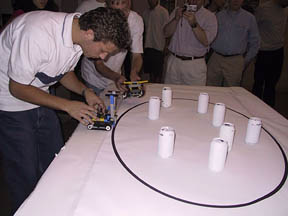
| In the midterm competition, Ralph Hunter sets up his robot, Mini-Ralph, to push a set of cans from the circle. (Photo: Gregory F. Welch) |
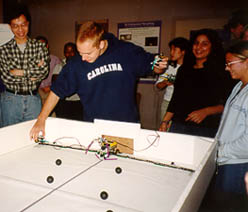
| In the final contest, Gabe Gales and the robot he built with Carlos Alves get ready to try putting balls into a goal. (Photo: Claire Stone) |
As in previous years, during 2001 and early 2002, we received a lot of press coverage. Areas attracting the most interest include augmented reality surgery, the dAb haptic painting system, digital mammography (part of the work of the Medical Image Display and Analysis Group [MIDAG]), image-based rendering, the nanoManipulator, tele-immersion, and walkthrough.In the Media
Our recent and upcoming print appearances include articles in Computer Graphics World, Das Compaq Magazin, Discover, The Economist, IEEE Computer, Mechanical Engineering, MIT Technology Review, Popular Science, Scientific American, and Wired, among others; as well as in two publications produced at UNC--the Carolina Alumni Review and Endeavors--and in several on-line publications. Newspaper coverage has ranged from local dailies, such as the Chapel Hill News, the Herald-Sun of Durham, and the News & Observer of Raleigh, to national and international papers including The New York Times, The Guardian (England), The Star (Canada), and Suddeutsche Zeitung (Germany).
Broadcast coverage of our research has included a February 2001 interview with Leandra Vicci, MSL director, about her patent for an automatic emergency warning device and GPS position indicator, which aired on the local NBC affiliate's evening news; and a nationally broadcast CBS Evening News segment in December 2001 on digital mammography, which featured MIDAG member Etta Pisano, M.D., of the Department of Radiology. Our nanoManipulator work appeared in Springboard, a PBS show airing in April 2001 in the San Francisco area. A three-part BBC television series, The Virtual World, broadcast in March and April 2002 in the United Kingdom, featured several of our research projects, including augmented reality surgery, effective virtual environments, nanotechnology, and tele-immersion. An upcoming documentary about nanomedicine being produced for the Discovery health channel will include footage of our nanotechnology work. WGBH-Boston is also featuring nanotechnology in the pilot for a new show, tentatively called Nova: Leading Edge.
For a complete list of press coverage, see: www.cs.unc.edu/Events/News/Media.html
Computer Services News
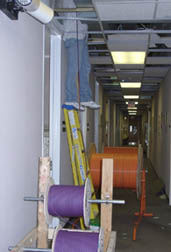
| Seeing a new side of Sitterson. One of the contractors working on the network upgrade project disappears into the second floor ceiling. (Photo: Herman Towles) |
Operating System Upgrades
John Sopko, UNIX systems manager, upgraded the
operating system on our Suns to Solaris 2.7. Murray
Anderegg (M.S. 1991), Linux and e-mail systems
administrator, upgraded our Linux systems to Red Hat
version 7.1. Charlie Bauserman, PC systems
administrator, upgraded the majority of our PC systems to
Microsoft Windows 2000 and Office 2000. These upgrades are
needed to keep up with the latest hardware and software and
to get needed security patches.
Remedy System Improvements
After shifting from our homegrown Problem System to the
Remedy System in December 1999, we developed methods to
separate user-logged tickets from those logged by Computer
Services staff, in order to deal with user issues more
quickly. Remedy also escalates the priority of issues as
they age and allows us to close tickets twice as quickly as
before, cutting our backlog by 80 percent.
Improved Video Class Facilities
In 2001, network coordinators David Musick and
David Harrison rewired the control room for the 011
classroom, set up an AMX control system, and replaced the
Alka-Seltzer tablet lights in the room with canister
lights. They also set up the 014 classroom for videotaping
and broadcasting.
Upgraded Dial-in Service
John Sopko and David Musick replaced our old
terminal server with one capable of 56-kilobit connections.
The new system also provides a simpler dial-in interface
and a single number for both PC and Mac users.
Mark Williams Lumsden (M.S. 1982) of Apex, N.C., died on 1 January 2002 at age 45. He is survived by his wife, Cindy Peters, and his children, Kira Anne and Kenny Peters Lumsden. He had worked at SAS Institute since June 2000, following 13 years at IBM Corp. In addition to an M.S. from our department, he earned a B.A. from UNC-Greensboro, where he was class valedictorian. Mark had been helping to start a new school for autism. Donations may be made in his name to: Mariposa School for Children with Autism, c/o 104 Park Knoll, Apex, N.C. 27502. (www.rtphome.org/mariposa)In Memoriam
Russel L. Vernor III (M.S. 1975) of South Jacksonville, Ill., died on 11 December 2001, at age 53. He is survived by his wife, Tina Vernor, and his daughter, Kate Vernor. He was the senior computer scientist for Computer Science Corp. (formerly Cybertek/John Deere Life) in Jacksonville. Before that, he was a professor and chairman of the Computer Science Department at MacMurray College, also in Jacksonville. He was a deacon and chairman of the trustees at the Congregational Church United Church of Christ. Donations in his name may be made to: Congregational Church UCC, 520 W. College Ave., Jacksonville, IL 62650, or Jacksonville Area Community Food Center, P.O. Box 1133, 316 E. State, Jacksonville, IL 62650.
About News & Notes
Editor:
Claire L. Stone,
stonec@cs.unc.edu
Throughout News & Notes, we list degree information for all our B.S., M.S., and Ph.D. Computer Science and Math Sciences alumni.
Keep in touch!
Let us know where you are and what you are
doing so that we can include you in our next issue!
Send us information via e-mail to pubs@cs.unc.edu;
fax it to 919-962-1799; or mail it to the address below,
c/o News & Notes. If you fax or mail your
information, please include your e-mail address.
Department of Computer Science
The University of North Carolina at Chapel Hill
CB#3175, Sitterson Hall
Chapel Hill, NC 27599-3175
General information:
Voice: 919/962-1700
Fax: 919/962-1799
Internet mail:
info@cs.unc.edu
World Wide Web:
www.cs.unc.edu
Address corrections, submissions, and for information about our publications: pubs@cs.unc.edu
UNC is an Equal Opportunity/Affirmative Action Institution.